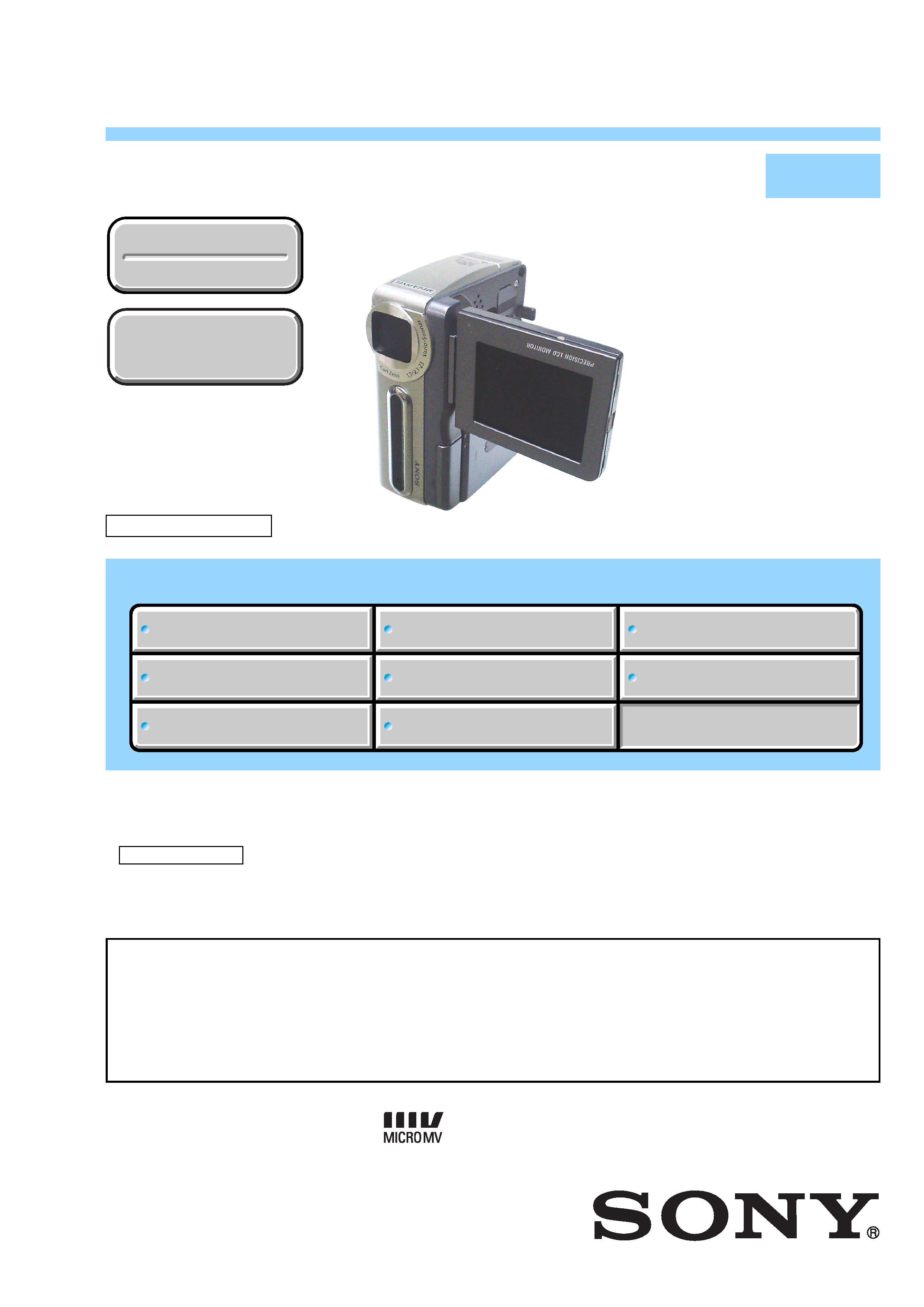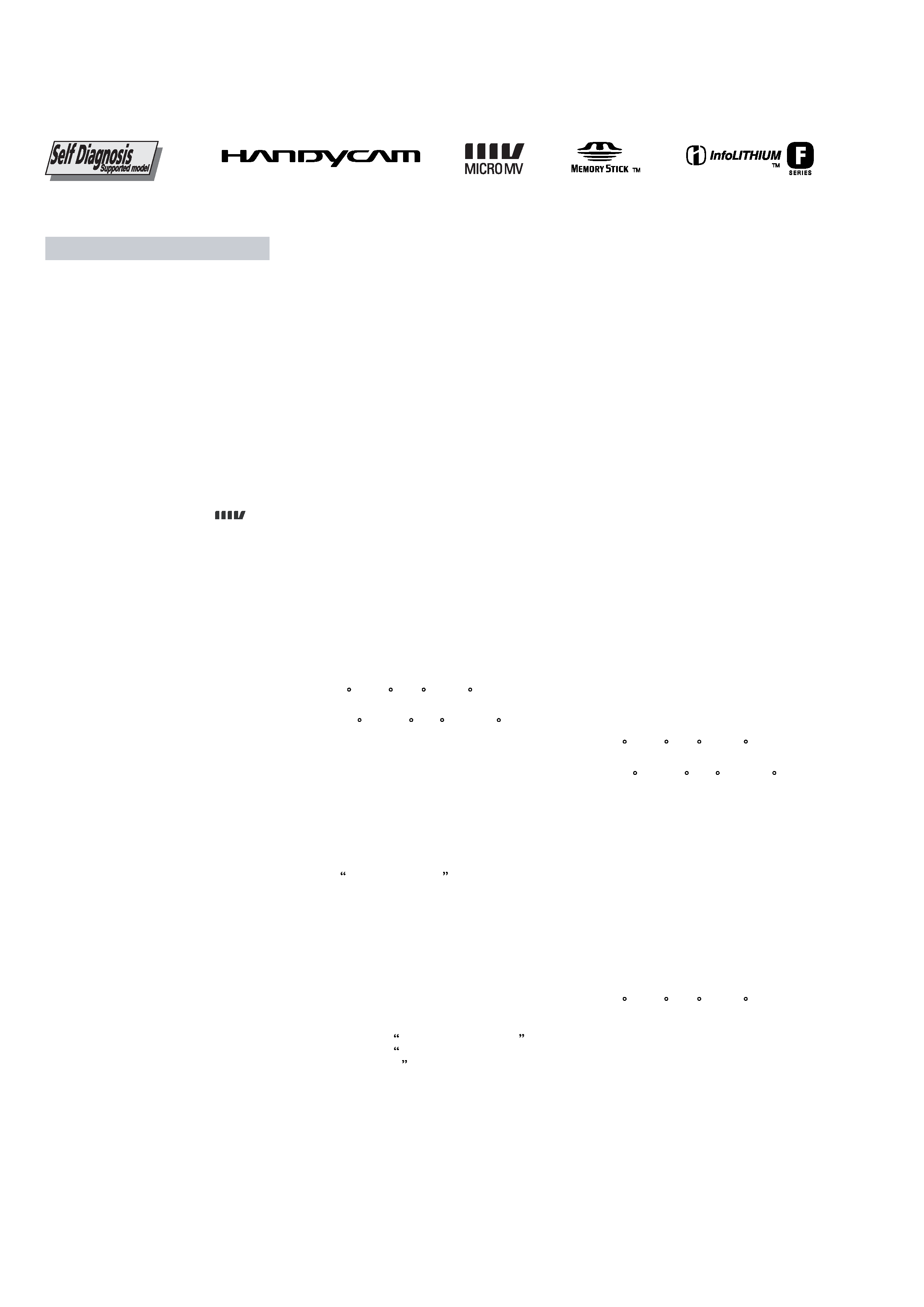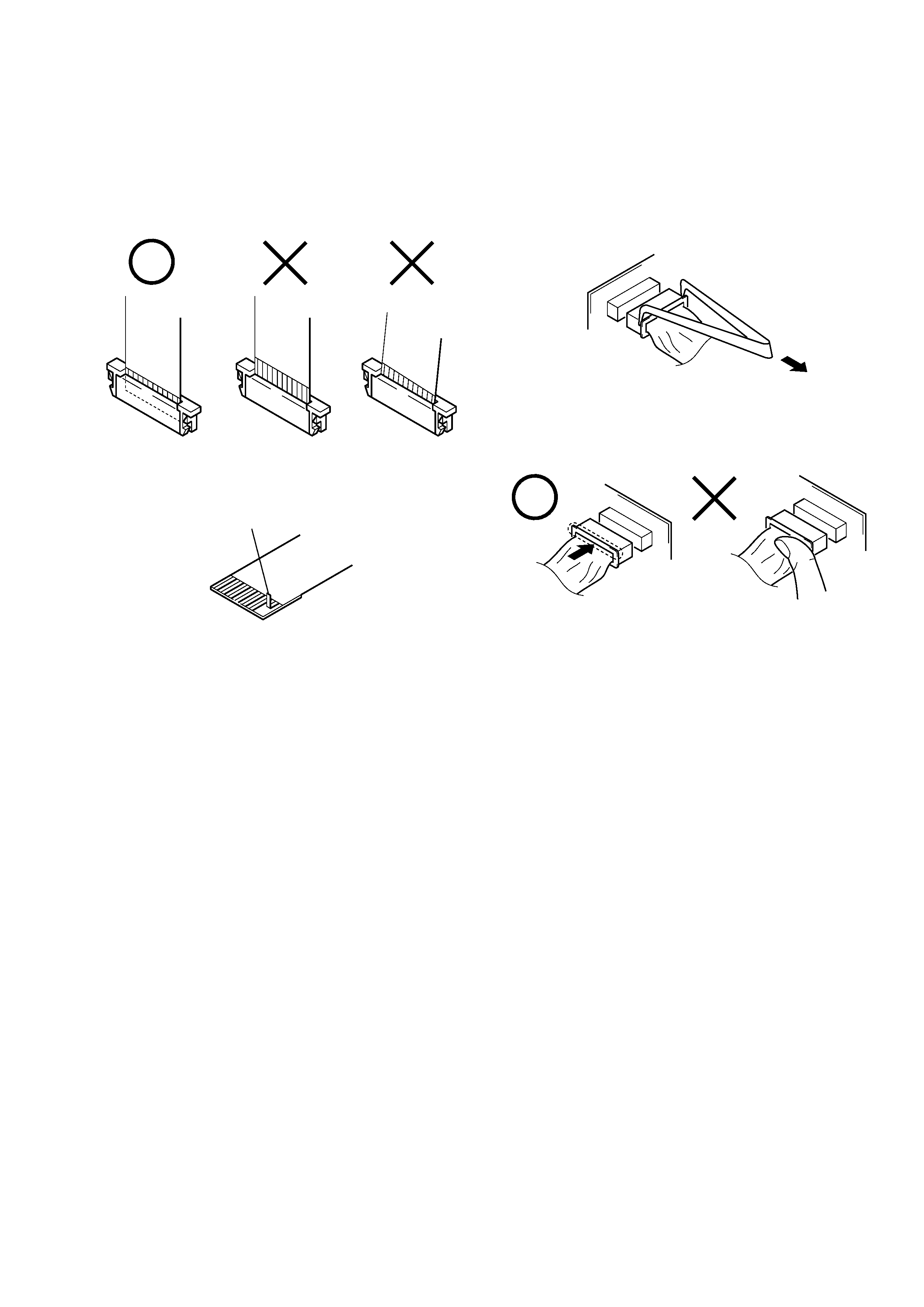
SERVICE MANUAL
DIGITAL VIDEO CAMERA RECORDER
LEVEL
2
Link
SERVICE NOTE
DISASSEMBLY
BLOCK DIAGRAMS
FRAME SCHEMATIC DIAGRAMS
SCHEMATIC DIAGRAMS
PRINTED WIRING BOARDS
REPAIR PARTS LIST
SPECIFICATIONS
SERVICE NOTE
DISASSEMBLY
BLOCK DIAGRAMS
FRAME SCHEMATIC DIAGRAMS
SCHEMATIC DIAGRAMS
PRINTED WIRING BOARDS
REPAIR PARTS LIST
SPECIFICATIONS
Link
Revision History
Revision History
W100 MECHANISM
Ver 1.0 2003. 10
·For ADJUSTMENTS (SECTION 6), refer to SERVICE MANUAL, ADJ (987626751.pdf).
·For INSTRUCTION MANUAL, refer to SERVICE MANUAL, LEVEL1 (987626741.pdf).
·For MECHANISM ADJUSTMENTS, refer to the "MICRO MV MECHANICAL ADJUSTMENT MANUAL
2
W MECHANISM " (9-876-276-11).
· Reference No. search on printed wiring boards is available.
· HELP: Sheet attachment positions and procedures of processing the flexible boards/harnesses are shown.
·TO TAKE OUT A CASSETE WHEN NOT EJECT (FORCE EJECT)
DCR-IP1/IP1E
RMT-832
On the CD-458 and VC-333 boards
This service manual provides the information that is premised the circuit board replacement service and not intended repair
inside the CD-458 and VC-333 boards.
Therefore, schematic diagrams, printed wiring boards, mounted parts location and electrical parts list of the CD-458 and VC-
333 boards are not shown.
The following pages are not shown.
Schematic diagrams ........................... Pages 4-9 to 4-46
Printed wiring boards .......................... Pages 4-65 to 4-70
Mounted parts location .................. Pages 4-85 to 4-87
Electrical parts list ......................... Pages 5-14 and 5-18 to 5-26
How to use
Acrobat Reader
How to use
Acrobat Reader
US Model
Canadian Model
Korea Model
DCR-IP1
AEP Model
UK Model
East European Model
Chinese Model
Australian Model
Hong Kong Model
DCR-IP1E
E Model
Tourist Model
DCR-IP1/IP1E

-- 2 --
DCR-IP1/IP1E
SPECIFICATIONS
Video camera recorder
System
Video recording system
2 rotary heads
Helical scanning system
Still image recording system
Exif Ver. 2.2*
Audio recording system
MPEG1 Audio Layer2
(Fs 48 kHz, stereo)
Video signal
PAL color, CCIR standards
Usable cassette
MICROMV cassette with the
m
DCR-IP1:
DCR-IP1E:
NTSC color, EIA standards
ark printed
Tape speed
Approx. 5.66 mm/s
Recording/playback time (using an MGR60
cassette)
Approx. 60 min
Fast forward/rewind time (using a MGR60
cassette)
Approx. 1 min, and 30 s
Image device
3.6 mm (1/5.0 type) CCD (Charge
Coupled Device)
Gross: Approx. 1 070 000 pixels
Effective (still): Approx. 1 000 000
pixels
Effective (moving): Approx. 690 000
pixels
Lens
Carl Zeiss Vario-Sonnar
Combined power zoom lens
10
× (Optical), 120 × (Digital)
F = 1.8 ~ 2.3
Focal length
3.2 - 32 mm (5/32 - 1 5/16 in.)
When converted to a 35 mm still camera
In CAMERA-TAPE:
46 - 460 mm (1 13/16 - 18 1/8 in.)
In CAMERA-MEM:
38 - 380 mm (1 1/2 - 15 in.)
Color temperature
[AUTO], [HOLD], [INDOOR] (3 200
K), [OUTDOOR] (5 800 K)
Minimum illumination
7 lx (lux) (F 1.8)
*Exif is a file format for still images, established
by the JEITA (Japan Electronics and
Information Technology Industries
Association). Files in this format can have
additional information such as camera settings.
Input/Output connectors
Audio/Video input/output
10-pin connector
Input/output auto switch
Video signal: 1 Vp-p, 75
(ohms),
unbalanced, sync negative
Luminance signal: 1 Vp-p, 75
(ohms),
unbalanced
Chrominance signal:
DCR-IP1: 0.286 Vp-p,
DCR-IP1E: 0.3 Vp-p,
75
(ohms), unbalanced
Audio signal: 327 mV, (at output
impedance more than 47 k
(kilohms))
Input impedance more than 47 k
(kilohms)
Output impedance with less than 2.2 k
(kilohms)
LCD screen
Picture
5.0 cm (2.0 type)
Total dot number
211 200 (960
× 220)
General
Power requirements
DC 7.2 V (battery pack)
DC 8.4 V (AC Adaptor)
Average power consumption (when using the
battery pack)
During camera recording using LCD
with the normal brightness
3.8 W
Operating temperature
0 C to 40 C (32 F to 104 F)
Storage temperature
-20 C to + 60 C (-4 F to + 140 F)
Dimensions (approx.)
39
× 91 × 69 mm (1 9/16 × 3 5/8 × 2 3/4
in.) (w/h/d)
Mass (Approx.)
230 g (8 oz) main unit only
280 g (10 oz) including the NP-FF51
rechargeable battery pack, MGR60
cassette.
Supplied accessories
Handycam Station DCRA-C100
Audio/Video input/output
10-pin connector
Input/output auto switch
Video signal:1 Vp-p, 75
(ohms),
unbalanced, sync negative
Luminance signal: 1 Vp-p, 75
(ohms),
unbalanced
Audio signal: 327 mV, (at output
impedance more than 47 k
(kilohms))
Input impedance more than 47 k
(kilohms)
Output impedance with less than 2.2 k
(kilohms)
USB jack
mini-B
i.LINK (MICROMV) input/output
4-pin connector S400
AC Adaptor AC-L25A/L25B
Power requirements
AC 100 - 240 V, 50/60 Hz
Current consumption
0.35 - 0.18 A
Power consumption
18 W
Output voltage
DC 8.4 V, 1.5 A
Operating temperature
0 C to 40 C (32 F to 104 F)
Storage temperature
-20 C to + 60 C (-4 F to + 140 F)
Dimensions (approx.)
56
× 31 × 100 mm (2 1/4 × 1 1/4 × 4 in.)
(w/h/d) excluding projecting parts
Mass (approx.)
190 g (6.7 oz) excluding the power cord
Rechargeable battery pack (NP-FF51)
Maximum output voltage
DC 8.4 V
Output voltage
DC 7.2 V
Capacity
5.6 Wh (780 mAh)
Operating temperature
0 C to 40 C (32 F to 104 F)
Dimensions (approx.)
40.8
× 12.5 × 49.1 mm (1 5/8 × 1/2 × 1
15/16 in.) (w/h/d)
Mass (approx.)
45 g (1.6 oz)
Type
Lithium ion
Design and specifications are subject to change
without notice.
Memory Stick Duo adaptor (1)
AC Adaptor (1)
Power cord (1)
Handycam Station DCRA-C100 (1)
Wireless Remote Commander (1)
A/V connecting cable (1)
USB cable (1)
Hand strap (1)
Rechargeable battery pack NP-FF51 (1)
Battery terminal cover (1)
MICROMV (1)
Cleaning cloth (1)
Camera Operations Guide (1)
Computer Applications Guide (1)
MovieShaker Applications Guide (1)
21-pin adaptor (1)
(AEP, UK, EE)
2-pin conversion adaptor (1)
(E, HK, JE)
See page 5-27.
Chrominance signal:
DCR-IP1: 0.286 Vp-p,
DCR-IP1E: 0.3 Vp-p,
75
(ohms), unbalanced
Memory Stick Duo 8MB (1)
CD-ROM SPVD-010 USB Driver (1)
CD-ROM MovieShaker Ver.3.1 for
·Abbreviation
AUS: Australian model
CH : Chinese model
CND : Canadian model
EE
: East European model
JE
: Tourist model
HK : Hong Kong model
KR
: Korean model

-- 3 --
DCR-IP1/IP1E
SAFETY-RELATED COMPONENT WARNING!!
COMPONENTS IDENTIFIED BY MARK 0 OR DOTTED LINE WITH
MARK 0 ON THE SCHEMATIC DIAGRAMS AND IN THE PARTS
LIST ARE CRITICAL TO SAFE OPERATION. REPLACE THESE
COMPONENTS WITH SONY PARTS WHOSE PART NUMBERS
APPEAR AS SHOWN IN THIS MANUAL OR IN SUPPLEMENTS
PUBLISHED BY SONY.
ATTENTION AU COMPOSANT AYANT RAPPORT
À LA SÉCURITÉ!
LES COMPOSANTS IDENTIFÉS PAR UNE MARQUE 0 SUR LES
DIAGRAMMES SCHÉMATIQUES ET LA LISTE DES PIÈCES SONT
CRITIQUES POUR LA SÉCURITÉ DE FONCTIONNEMENT. NE
REMPLACER CES COMPOSANTS QUE PAR DES PIÈSES SONY
DONT LES NUMÉROS SONT DONNÉS DANS CE MANUEL OU
DANS LES SUPPÉMENTS PUBLIÉS PAR SONY.
1.
Check the area of your repair for unsoldered or poorly-soldered
connections. Check the entire board surface for solder splashes
and bridges.
2.
Check the interboard wiring to ensure that no wires are
"pinched" or contact high-wattage resistors.
3.
Look for unauthorized replacement parts, particularly
transistors, that were installed during a previous repair. Point
them out to the customer and recommend their replacement.
4.
Look for parts which, through functioning, show obvious signs
of deterioration. Point them out to the customer and
recommend their replacement.
5.
Check the B+ voltage to see it is at the values specified.
6.
Flexible Circuit Board Repairing
·Keep the temperature of the soldering iron around 270°C
during repairing.
· Do not touch the soldering iron on the same conductor of the
circuit board (within 3 times).
· Be careful not to apply force on the conductor when soldering
or unsoldering.
Unleaded solder
Boards requiring use of unleaded solder are printed with the lead-
free mark (LF) indicating the solder contains no lead.
(Caution: Some printed circuit boards may not come printed with
the lead free mark due to their particular size.)
: LEAD FREE MARK
Unleaded solder has the following characteristics.
· Unleaded solder melts at a temperature about 40
°C higher than
ordinary solder.
Ordinary soldering irons can be used but the iron tip has to be
applied to the solder joint for a slightly longer time.
Soldering irons using a temperature regulator should be set to
about 350
°C.
Caution: The printed pattern (copper foil) may peel away if the
heated tip is applied for too long, so be careful!
· Strong viscosity
Unleaded solder is more viscous (sticky, less prone to flow) than
ordinary solder so use caution not to let solder bridges occur such
as on IC pins, etc.
· Usable with ordinary solder
It is best to use only unleaded solder but unleaded solder may
also be added to ordinary solder.
SAFETY CHECK-OUT
After correcting the original service problem, perform the following
safety checks before releasing the set to the customer.

-- 4 --
DCR-IP1/IP1E
TABLE OF CONTENTS
1.
SERVICE NOTE
1-1.
Note for Repair ································································ 1-1
1-2.
Power Supply During Repairs ········································· 1-1
1-3.
To Take Out a Cassette when not Eject (Force Eject) ····· 1-2
1-4.
Self-diagnosis Function
1-4-1. Self-diagnosis Function ··················································· 1-3
1-4-2. Self-diagnosis Display ····················································· 1-3
1-4-3. Self-diagnosis Code Table ··············································· 1-4
2.
DISASSEMBLY
Service Position: LCD Module ······································· 2-3
Service Position to Check the VTR Section ···················· 2-4
2-1.
Top Cabinet Assembly ····················································· 2-5
2-2.
F Panel Block Assembly ·················································· 2-5
2-3.
Gear With Motor (Lens Cover) (M904),
FP-731 Flexible Board ···················································· 2-6
2-4.
Lens Shutter, Lens Ornamental Plate ······························ 2-6
2-5.
Cabinet R Block Assembly ·············································· 2-7
2-6.
FP-732/FP-734 Flexible Board ······································· 2-7
2-7.
MS-153 Board ································································· 2-8
2-8.
PD-199 Board, LCD Module ·········································· 2-8
2-9.
Hinge Assembly, FP-733 Flexible Board ························ 2-9
Installation of FP-733 Flexible Board ··························· 2-10
2-10. IF-108 Board ································································· 2-11
2-11. SE-139 Board, Mic Unit ················································ 2-11
2-12. Lens Block Assembly ···················································· 2-12
2-13. CD-458 Board ······························································· 2-12
2-14. Cabinet G ······································································· 2-13
2-15. Cabinet L Assembly ······················································ 2-13
2-16. VC-333 Board ······························································· 2-14
2-17. Mechanism Deck ··························································· 2-14
2-18. Operation Switch Block (PW4720) ······························· 2-15
2-19. Grip Cover ····································································· 2-15
2-20. Circuit Boards Location ················································ 2-16
2-21. Flexible Boards Location ·············································· 2-17
3.
BLOCK DIAGRAMS
3-1.
Overall Block Diagram (1/6) ··········································· 3-1
3-2.
Overall Block Diagram (2/6) ··········································· 3-3
3-3.
Overall Block Diagram (3/6) ··········································· 3-5
3-4.
Overall Block Diagram (4/6) ··········································· 3-7
3-5.
Overall Block Diagram (5/6) ··········································· 3-9
3-6.
Overall Block Diagram (6/6) ········································· 3-11
3-7.
Power Block Diagram (1/3) ··········································· 3-13
3-8.
Power Block Diagram (2/3) ··········································· 3-15
3-9.
Power Block Diagram (3/3) ··········································· 3-17
Section
Title
Page
Section
Title
Page
4.
PRINTED WIRING BOARDS AND
SCHEMATIC DIAGRAMS
4-1.
Frame Schematic Diagrams
Frame Schematic Diagram (1/2) ····································· 4-1
Frame Schematic Diagram (2/2) ····································· 4-3
4-2.
Schematic Diagrams ························································ 4-5
FP-723 FLEXIBLE (CCD IMAGER) ····························· 4-7
PD-199 (LCD DRIVE) ·················································· 4-47
IF-108 (CRADLE TERMINAL) ··································· 4-49
MS-153 (MS CONNECTOR) ······································· 4-51
SE-139 (PITCH/YAW SENSOR) ·································· 4-53
DH-041, FP-080, FP-081, FP-228 FLEXIBLE ············· 4-55
FP-731, FP-769 FLEXIBLE ·········································· 4-56
FP-732, FP-733, FP-734 FLEXIBLE ···························· 4-57
CF4720, SS4720, PW4720
(CONTROL SWITCH BLOCK) ··································· 4-59
4-3.
Printed Wiring Boards ··················································· 4-63
PD-199 ··········································································· 4-71
IF-108 ············································································ 4-73
MS-153 ·········································································· 4-75
SE-139 ··········································································· 4-77
DH-041, FP-080, FP-081, FP-228 FLEXIBLE ············· 4-79
FP-731, FP-769 FLEXIBLE ·········································· 4-80
FP-732, FP-733, FP-734 FLEXIBLE ···························· 4-81
4-4.
Mounted Parts Location ················································ 4-88
5.
REPAIR PARTS LIST
5-1.
Exploded Views ···························································· 5-2
5-1-1. Overall Assembly ·························································· 5-2
5-1-2. F Panel Block Assembly ··············································· 5-3
5-1-3. Cabinet R Block Assembly-1 ········································ 5-4
5-1-4. Cabinet R Block Assembly-2 ········································ 5-5
5-1-5. Cabinet L Block Assembly-1 ········································ 5-6
5-1-6. Cabinet L Block Assembly-2 ········································ 5-7
5-1-7. Lens Block Assembly ··················································· 5-8
5-1-8. Mic Block Assembly ····················································· 5-9
5-1-9. MD Frame Block Assembly ······································· 5-10
5-1-10. Overall Mechanism Deck Section (W100) ················· 5-11
5-1-11. LS Chassis Block Assembly ······································· 5-12
5-1-12. Mechanism Chassis Block Assembly ························· 5-13
5-2.
Electrical Parts List ····················································· 5-14

1-1
SECTION 1
SERVICE NOTE
DCR-IP1/IP1E
1-1. NOTE FOR REPAIR
Make sure that the flat cable and flexible board are not cracked of
bent at the terminal.
Do not insert the cable insufficiently nor crookedly.
Cut and remove the part of gilt
which comes off at the point.
(Be careful or some
pieces of gilt may be left inside)
When remove a connector, don't pull at wire of connector.
It is possible that a wire is snapped.
When installing a connector, don't press down at wire of connector.
It is possible that a wire is snapped.
1-2. POWER SUPPLY DURING REPAIRS
In this unit, about 10 seconds after power is supplied to the battery terminal using the regulated power supply (8.4V), the power is shut off so
that the unit cannot operate.
The following method is available to prevent this.
Method 1.
Use the AC power adaptor (AC-L25A/L25B etc.).
